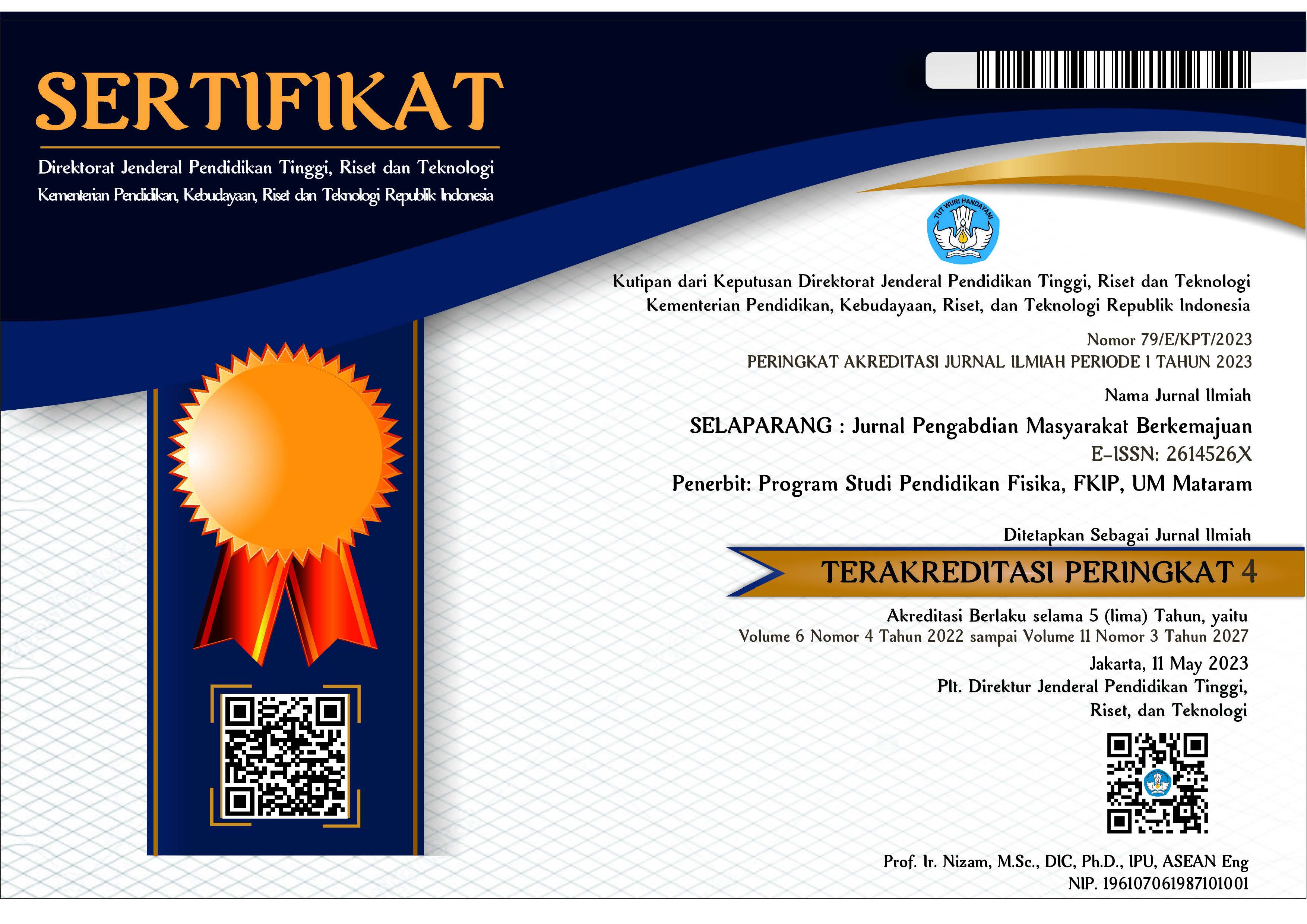PELATIHAN PEMBUATAN HAND SANITIZER KEPADA MASYARAKAT DI DESA KALIPLOSO KABUPATEN BANYUWANGI
Abstract
ABSTRAK
COVID-19 merupakan jenis virus yang dapat menyebar secara masif dan ditetapkan sebagai pandemi global. Adanya pandemi ini telah mengubah tata cara kehidupan manusia di hampir seluruh Negara. Kebiasaan menjaga protokol kesehatan dan menerapkan pola hidup bersih dan sehat perlu dilakukan oleh seluruh kalangan masyarakat. Selanjutnya, salah satu upaya Pemerintah Indonesia dalam memutus rantai COVID-19 dengan vaksinasi, namun hingga saat ini jumlah kasus aktif masih terus bertambah. Hal ini tentunya menjadi tujuan utama dari program ini untuk terus mengedukasi masyarakat dan melakukan sosialisasi akan pentingnya menjaga, perilaku hidup sehat. Kegiatan pengabdian ini dilaksanakan di Desa Kaliploso kecamatan Cluring Kabupaten Banyuwangi. Adapun kegiatan ini dilakukan beberapa tahap diantaranya tahap persiapan dan pembekalan, dilanjutkan dengan praktik langsung di Balai Desa Kaliploso. Hasil pelaksanaannya adalah masyarakat setempat diberikan edukasi dan dilatih untuk membuat hand sanitizer sesuai dengan formula World Health Organization (WHO). Kegiatan ini merupakan salah satu implementasi upaya pola hidup sehat dan bersih guna mencegah penyebaran COVID-19. Selain itu, kegiatan ini diharapkan dapat menjadi keterampilan masyarakat Desa Kaliploso untuk membuat hand sanitizer secara mandiri.
Kata kunci: COVID-19; Desa Kaliploso; Banyuwangi; hand sanitizer.
ABSTRACT
COVID-19 is a type of virus that can spread through massively and is declared a global pandemic. The existence of this pandemic has changed the way of human life in almost all countries. The habit of maintaining health protocols and implementing a clean and healthy lifestyles need to be carried out by all levels of society. Furthermore, one of the efforts from Indonesian government in breaking the chain of COVID-19 transmission is by vaccination, but until now the number of active cases is increasing. This is certainly the main goal from this program to continue educating the public and socializing the importance of healthy living behavior. This service activity was carried out in Kaliploso Village, Cluring Sub-district, Banyuwangi Regency. This activity was done by several stages including the preparation and debriefing stage, followed by direct practice at the Kaliploso’s Village Hall. The results of implementation are local people that are given of education and trained to make hand sanitizers according to the World Health Organization (WHO). This activity is one of the implementations of a healthy and clean lifestyles to prevent the spread of COVID-19. In addition, this activity is expected to be a skill for the Kaliploso Village community to make hand sanitizers independently.
Keywords: COVID-19; Kaliploso Village; Banyuwangi; hand sanitizer.
Keywords
Full Text:
PDFReferences
Desiyanto, F. A., & Djannah, S. N. (2013). Efektivitas Mencuci Tangan Menggunakan Cairan Pembersih Tangan Antiseptik (Hand Sanitizer) Terhadap Jumlah Angka Kuman. Jurnal Kesehatan Masyarakat, 7(2), 75–82. https://doi.org/10.12928/kesmas.v7i2.1041
Elias, C., Sekri, A., Leblanc, P., Cucherat, M., & Vanhems, P. (2021). The incubation period of COVID-19: A meta-analysis. International Journal of Infectious Diseases, 104, 708–710. https://doi.org/10.1016/j.ijid.2021.01.069
Golin, A. P., Choi, D., & Ghahary, A. (2020). Hand sanitizers: A review of ingredients, mechanisms of action, modes of delivery, and efficacy against coronaviruses. American Journal of Infection Control, 48(9), 1062–1067. https://doi.org/10.1016/j.ajic.2020.06.182
Hamijaya, L., Prihatiningsih, P., & Widiastuti, G. (2014). Perbedaan daya anti bakteri tertachlordecaoxide, povidon iodine dan hidrogen peroksida (H2O2) terhadap bakteri Pseudomonas aeruginosa secara in vitro. J KEd Gi, 5(4), 329–335. Retrieved from https://journal.ugm.ac.id/jkg/article/viewFile/29328/17503
Kampf, G., Todt, D., Pfaender, S., & Steinmann, E. (2020). Persistence of coronaviruses on inanimate surfaces and their inactivation with biocidal agents. Journal of Hospital Infection, 104(3), 246–251. https://doi.org/10.1016/j.jhin.2020.01.022
Kim, H., Kim, J. T., Barua, S., Yoo, S. Y., Hong, S. C., Lee, K. Bin, & Lee, J. (2018). Seeking better topical delivery technologies of moisturizing agents for enhanced skin moisturization. Expert Opinion on Drug Delivery, 15(1), 17–31. https://doi.org/10.1080/17425247.2017.1306054
Rahmani, A. R., Leili, M., Azarian, G., & Poormohammadi, A. (2020). Sampling and detection of corona viruses in air: A mini review. Science of the Total Environment, 740, 140207. https://doi.org/10.1016/j.scitotenv.2020.140207
Syafrida, S., & Hartati, R. (2020). Bersama Melawan Virus Covid 19 di Indonesia. SALAM: Jurnal Sosial Dan Budaya Syar-I, 7(6), 495–508. https://doi.org/10.15408/sjsbs.v7i6.15325
Thorik, S. H. (2020). Efektivitas Pembatasan Sosial Berskala Besar Di Indonesia Dalam Penanggulangan Pandemi Covid-19. Jurnal Adalah: Buletin Hukum Dan Keadilan, 4(1), 115–120.
DOI: https://doi.org/10.31764/jpmb.v4i3.5388
Refbacks
- There are currently no refbacks.

This work is licensed under a Creative Commons Attribution-ShareAlike 4.0 International License.
______________________________________________________
Jurnal Selaparang
p-ISSN 2614-5251 || e-ISSN 2614-526X
EDITORIAL OFFICE:



















